Wallachia is a historical region that played a crucial role in shaping the national identity of Romania and in the broader history of Southeastern Europe. Situated between the Carpathian Mountains and the Danube River, it was the stage for numerous wars, political shifts, and persistent efforts to gain independence. Known not only for its heroic past but also for its rich cultural heritage and legends, Wallachia continues to fascinate historians and travelers alike. These captivating and interesting facts about Wallachia offer deeper insight into its historical significance and contribution to the formation of modern Romania. You may not have known how much of Europe’s heritage has roots in this region.
- Wallachia emerged as an independent principality in the mid-14th century. Its founder is considered to be Basarab I, who secured victory over Hungarian forces at the Battle of Posada. This triumph ensured Wallachia’s de facto independence from the Kingdom of Hungary. The name “Wallachia” comes from an ethnonym used by neighboring peoples to refer to Romance-speaking populations.
- The region was traditionally divided into two parts: Muntenia (Upper Wallachia) and Oltenia (Lower Wallachia). This division had both administrative and cultural significance. Each region had its own architectural styles, folklore, and dialectal differences. However, Wallachia was always politically recognized as a unified principality.
- One of the most famous rulers of Wallachia was Vlad III, also known as Vlad the Impaler or Dracula. He ruled in the 15th century and became legendary for his fierce resistance against the Ottoman Empire and his harsh methods of governance. His figure inspired Bram Stoker’s famous novel Dracula. To the Romanian people, he remains a national hero and a symbol of defiance.
- Over time, Wallachia had several capitals, including Argeș, Târgoviște, and eventually Bucharest. In the 17th century, Bucharest became the main administrative and political center. Its prominence grew due to its strategic location on major trade routes. Eventually, it became the capital of a unified Romania.
- For centuries, Wallachia existed under the influence of the Ottoman Empire, Austria, and Russia. Although it maintained formal autonomy, its rulers were often required to pay tribute and align their foreign policies with the will of the Ottoman court. This arrangement lasted for over three hundred years. Despite external pressures, Wallachia preserved its internal institutions and traditions.
- Many Wallachian princes received their education abroad and maintained strong ties with European courts. They studied in places such as Constantinople, Vienna, and Paris. This exposure to Western thought fostered openness to intellectual innovation and reform. As a result, printing and literary translation flourished in the principality.
- Eastern Orthodoxy was the dominant religion in Wallachia and played a central role in public and state life. The Church not only provided spiritual guidance but also education and social services. The famous Curtea de Argeș Monastery became both a spiritual hub and a burial site for Wallachian rulers. Religion served as a powerful force in preserving national identity during times of foreign domination.
- The Wallachian military relied heavily on peasant levies, capable of rapid mobilization in times of conflict. These forces used traditional weapons such as bows, spears, and sabers. Their proficiency in mountain warfare gave them a tactical edge over more numerous adversaries. This advantage proved crucial in many historical battles.
- Wallachia minted its own currency, including ducats and paras. Although these coins were rarely used outside the principality, they symbolized sovereignty and economic independence. Archaeologists still discover examples of these coins throughout modern-day Romania. Their presence reflects a well-developed internal economy and trade system.
- Folk culture in Wallachia preserved many pre-Christian elements, which were later integrated into Christian practices. Motifs such as the sun, horse, and tree of life appeared in songs, embroidery, and pottery. These symbols played a meaningful role in the spiritual life of the people. Wallachian folklore shares many themes with other Balkan traditions.
- Rural communities in Wallachia had a strong tradition of self-governance. Villagers elected elders, judges, and maintained their own local regulations. This system of communal autonomy endured until the 19th century. It fostered a sense of civic responsibility and grassroots democracy.
- In the 18th century, the Ottoman Empire began appointing Phanariot rulers of Greek origin to govern Wallachia. These rulers often disregarded the needs of the local population, leading to increased discontent. Social tensions and uprisings became more frequent during this period. The Phanariot era set the stage for future national liberation movements.
- In 1821, Tudor Vladimirescu led an uprising against both Phanariot domination and Ottoman control. This movement marked one of the first expressions of Romanian national awakening. Although the revolt was ultimately suppressed, it had a lasting impact on the collective consciousness. It showed the people’s determination to fight for justice and independence.
- In the mid-19th century, Wallachia united with Moldavia to form the United Principalities. This unification laid the foundation for the modern Romanian state. Alexandru Ioan Cuza was elected ruler of both principalities, initiating a new era of political transformation. The union was a peaceful and decisive turning point in Romanian history.
- The traditions of Wallachia live on in Romania’s culture, music, architecture, and language. Many villages still preserve ancient houses, folk crafts, and ceremonial practices rooted in the Wallachian past. Local holidays remain rich in symbolism and ancestral meaning. Wallachia continues to be a source of national pride and cultural identity.
These incredible facts about Wallachia reveal the depth and richness of its historical legacy. Once a principality forged through struggle and resilience, it became a cornerstone of Romanian nationhood. You may not have known how central Wallachia was to the history of Eastern Europe. Today, its heritage endures in traditions, memory, and the soul of a people.





